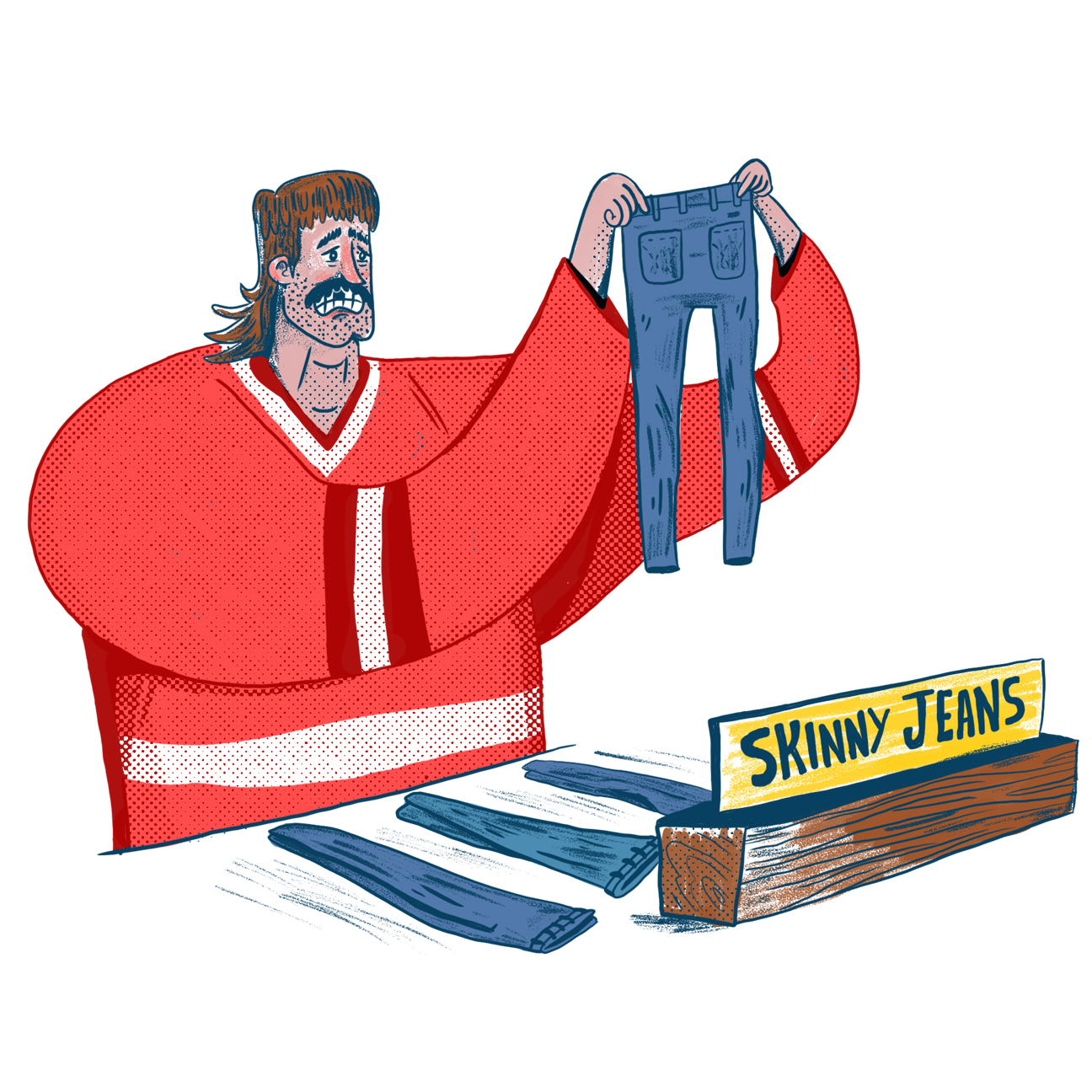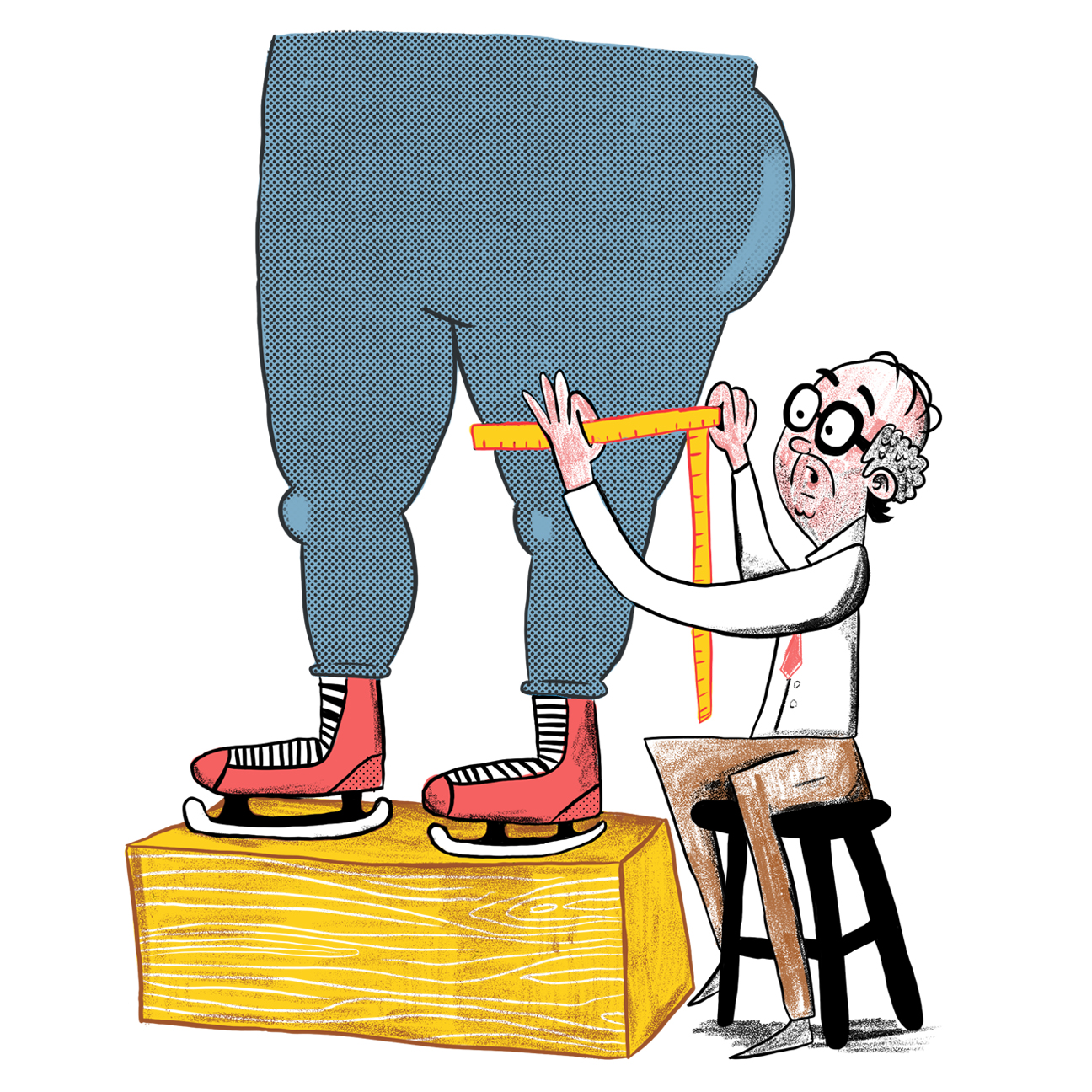Edmonton Oilers captain Connor McDavid has worked his butt off to be the best hockey player in the world. He has consulted with a skills coach since age 11. Coaches gush over his effectiveness with crossovers; he pivots and cuts as well as anyone. A six-second clip of his edge work posted to Instagram last summer -- him breezing around metal bars on the ice while remaining low on his turns and somehow keeping control of the puck -- has more than 300,000 views (and 800-plus comments, with most followers in awe).
All of that training, however, came with a sacrifice: He didn't work his butt off at all. Actually, his lower half became too big to fit into most pants.
"Can it be hard for me to find pants? Yes, always," McDavid says. "The waist, you need to get around your thighs and butt, but that doesn't always match how tall you are. I definitely have a hard time finding jeans that fit."
He's hardly alone. "I have had trouble," Dallas Stars captain Jamie Benn says. "I just need to find the right company. Jeans are the hardest."
Penguins forward Zach Aston-Reese forgot to bring jeans on a road trip earlier this season. So while the team was in Ottawa, Aston-Reese ventured to the Levi's store. That's when he received a call from teammate Derek Grant. "Are you still shopping?" Grant asked. "Can you buy me a pair?"
"Sure," Aston-Reese said. "What size?"
"34," Grant said.
"No way!" Aston-Reese replied.
Aston-Reese is technically a 34 waist himself, but he always buys a size 36 "because my butt won't fit in a 34," he says. "Derek is bigger than me," Aston-Reese adds. "So there we are, having an argument in the Levi's store, because I was sure I was right."
Several NHL players express their struggles with finding a pair of jeans that fits properly.
Not everyone fits into the same exact mold, making the sweet spot for size unique for every player.
"I've never really talked about it," Blackhawks captain Jonathan Toews says. "But it's definitely a thing a lot of guys go through."
"It's an absolute nightmare between the quads and the glutes," Montreal Canadiens center Max Domi says. "The glutes especially, because it just throws off your waist. You have, like, a 48 waist with your ass, but without it, you're a 32. So what do you do? Meet halfway, and you still have all this extra stuff."
New York Islanders winger Anders Lee often goes to the mall with his wife. "I'll try on, like, 40 pairs of pants or jeans," he laments, "and we'll walk away with one ... or none. Oh, and anything that says 'skinny'? Trust me, I'm not getting into that."
Last month, Blackhawks defenseman Connor Murphy spent an off day at Bloomingdale's. He tried on about 10 pairs of jeans and none of them fit. "I got so mad, I hate shopping," Murphy says. "But the saleswoman was really helpful and spent a lot of time with me, so I literally bought a pair because I felt bad for her -- even though they didn't fit and I knew I was going to return them later. I just had guilt."
"There's definitely some pants I can't really fit into," says reigning league MVP Taylor Hall of the Devils. "Some shorts that maybe fit my waist but don't fit the other parts. It's a challenge. You want to have big legs in hockey. You want to be a guy who skates well and uses his power, for sure. But that means ..."
We'll finish Hall's thought: If your body makes you good at your job, it provides bad luck in the dressing room (of a department store, that is).

This might be a new phenomenon, coinciding with the evolution of hockey players' training and, therefore, their physiques. Domenico Vacca is the personal tailor to upward of 250 NHL players and some coaches. Since the 1980s, he has been flying around North America creating custom suits cut from his own fabric for some of the game's biggest stars.
"It's a lot different now than it used to be," Vacca says. "When I started, it was all about the upper body. The upper body was very big. Now, maybe six or seven years ago, I noticed the guys are all bigger in the thighs."
This make's Vacca's job especially important because the trend now is a tapered look. In the '90s, players would have a baggy 27 inches around the knee. Now it's more like 17 or 18.
Finding the right tailor is one way to go. Before Pittsburgh Penguins defenseman Jack Johnson discovered his brand of choice, Banana Republic, he says he would buy pants with "a waist so big that they'd get over my thighs, then get them tailored to the point where my back pockets were, like, touching. It looked ridiculous."
As for the larger-thigh phenomenon, it becomes more pronounced once a player gets to the NHL. For example, Vacca outfitted one player for the NHL draft in 2014. He recently visited that player to get him fitted for a new suit. "His upper body is the same, almost exactly the same measurements at the top," Vacca says. "His thighs were up an inch, and his hips were up two-and-a-half inches."
Of course, this doesn't apply to everyone. If you've ever stood next to Vegas Golden Knights goaltender Marc-Andre Fleury, you'll notice he's quite tall (6-foot-2) but slight. "I am fine buying pants," he says. "No problem."
Goalies have different needs. As for the men skating in front of him?
"I used to have to get the husky pants when I was a kid," Boston Bruins defenseman Charlie McAvoy admits. "Actually, once I became a Bruin, when I became a pro hockey player and had some walk-around money, then I discovered the jeans that were really soft, and they really fit to you. I got a couple pairs of those. But I just didn't wear jeans in college. I was a big sweatpants guy in college. Just Champion sweatpants. I roomed with Jordan Greenway -- he's a big boy -- and we would just wear sweatpants every day. We were the sweatpants and sweatshirts room."
Once players start to have more disposable income, they find some brands that work. McDavid and Benn swear by Paige denim, which is known to use stretchier material, though an average pair retails for $199. McDavid also discovered an Ottawa-based brand, Heritage 34, this summer. Florida Panthers center Vincent Trocheck is a Diesel guy. Norwegian-born Blackhawks winger Andreas Martinsen found a Swedish brand he liked. So he bought pairs in black, and blue, and another shade of blue ....
But not everything has to be too pricey, as long as one is willing to experiment. Once Philadelphia Flyers captain Claude Giroux discovered the chain Zara, he found a sense of relief. "I have smaller calves, too, for some reason," Giroux says. "Zara, their suits fit me perfectly for some reason, so I'm there often. That's the one place I can shop."
Those who aren't lucky enough to find a brand that works must resort to the more expensive option. "Over the last three years, I realized I could get it custom," veteran Minnesota Wild center Eric Staal says. "If you include the suits, I've spent a couple thousand, for sure." Anaheim Ducks defenseman Josh Manson usually buys size 36 pants at the store, which is too big for his waist, but he gets everything else tailored.
"Every pair of pants I have is custom," Domi says. "Whether it's jeans, joggers ... actually, I can get away with sweatpants, but that's it."

A few smart businesses have cornered the niche market.
Leo Tropeano is a former soccer player who noticed that most jeans are built on the bell curve for the "average guy." He consulted with 2010 Hobey Baker winner Blake Geoffrion and realized hockey players were even more disproportionate. Two years ago, Tropeano launched the Chicago-based Mugsy Jeans. Although the "custom denim that allows for flexibility" isn't directly catered to hockey players, Tropeano has noticed that's who has latched on most. He says about five out of every 10 people who come into the Chicago storefront end up being "hockey guys." It's no coincidence that Mugsy advertises on the popular "Spittin Chiclets" podcast.
The Canadian brand GongShow is even more overt. "The hockey world is really small. Everyone knows everyone," says founder and CEO Ger McNamee, a former junior hockey player. "Guys would come home in the summer, and if you noticed someone had a good-fitting pair of jeans, we'd all ask where they got it. If a guy found a pair, he'd order 10 to 12 pairs."
GongShow was founded in 2002 and proudly boasts the world's first pair of "hockey jeans." The pants are a little looser in the thighs, have more area in the butt, and mix in a little spandex to be more forgiving. "They're built for the hockey ass," McNamee says. The biggest pair of jeans GongShow offers is called the Quadrasaurus. The company has partnered with the CWHL, and in talking to women's players, it realized that finding properly fitting jeans isn't a gender-specific issue. The company launched a women's line last year.
Hockey players aren't alone. McNamee found that a slew of athletes from other sports -- downhill skiers, speed skaters and some weightlifters -- have the same problem finding pants.
Which brings us back to McDavid. As exceptional as he is at so many aspects of hockey -- on an unattainable level for most -- his struggle to find pants actually gives him comfort. It's one area where he's relatively normal.
"At least I know I'm not alone," he says.
